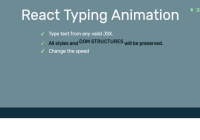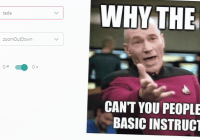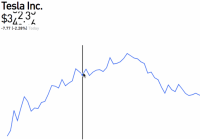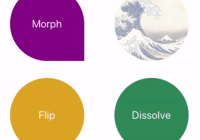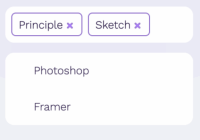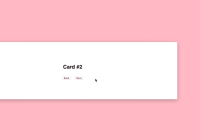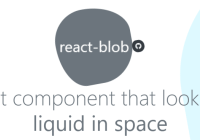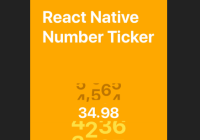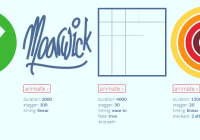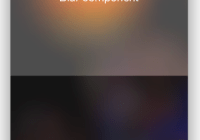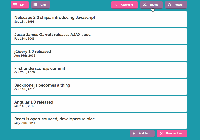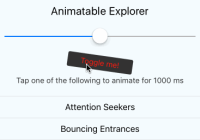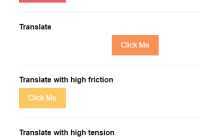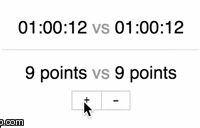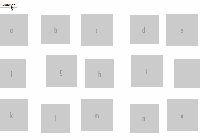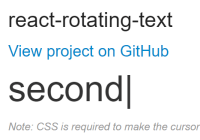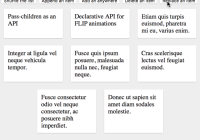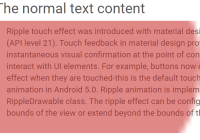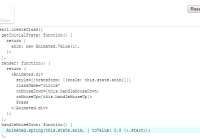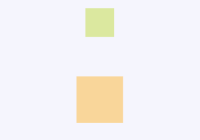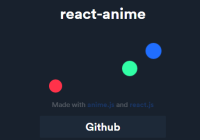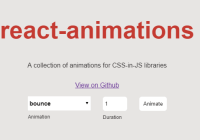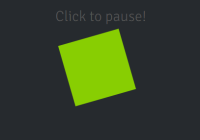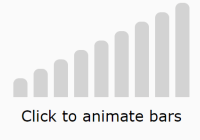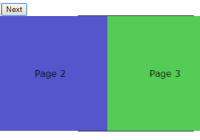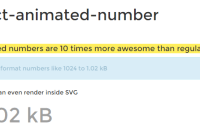react-state-animation
react-state-animation provides a capability to update React component's state value by requestAnimationFrame with a simple APIs that builds on d3-ease. The file size is just 4KB (minified).
This works with regular React component and React Canvas
Installation
npm install react-state-animation --save
Include the module by CommonJS way
import ReactStateAnimation from 'react-state-animation' or var ReactStateAnimation = require('react-state-animation');
This will require ES5 modules converted by babel. ES6 sources are in /src and converted ES5 modules are located in /lib.
##Demo http://tejitak.github.io/react-state-animation/examples/demo/
API
- linearIn(stateProp, endStateValue, duration)
- linearOut(stateProp, endStateValue, duration)
- linearInOut(stateProp, endStateValue, duration)
- quadIn(stateProp, endStateValue, duration)
- quadOut(stateProp, endStateValue, duration)
- quadInOut(stateProp, endStateValue, duration)
- cubicIn(stateProp, endStateValue, duration)
- cubicOut(stateProp, endStateValue, duration)
- cubicInOut(stateProp, endStateValue, duration)
- polyIn(stateProp, endStateValue, duration)
- polyOut(stateProp, endStateValue, duration)
- polyInOut(stateProp, endStateValue, duration)
- sinIn(stateProp, endStateValue, duration)
- sinOut(stateProp, endStateValue, duration)
- sinInOut(stateProp, endStateValue, duration)
- expIn(stateProp, endStateValue, duration)
- expOut(stateProp, endStateValue, duration)
- expInOut(stateProp, endStateValue, duration)
- circleIn(stateProp, endStateValue, duration)
- circleOut(stateProp, endStateValue, duration)
- circleInOut(stateProp, endStateValue, duration)
- bounceIn(stateProp, endStateValue, duration)
- bounceOut(stateProp, endStateValue, duration)
- bounceInOut(stateProp, endStateValue, duration)
- backIn(stateProp, endStateValue, duration)
- backOut(stateProp, endStateValue, duration)
- backInOut(stateProp, endStateValue, duration)
- elasticIn(stateProp, endStateValue, duration)
- elasticOut(stateProp, endStateValue, duration)
- elasticInOut(stateProp, endStateValue, duration)
The above API returns Promise, so you can chain additinal processes by using then.
##Usage
Example 1. Use outside of component
var yourComponent = React.render( <YourComponent />, document.getElementById('demo') ) var reactStateAnimation = new ReactStateAnimation(yourComponent) // your component's state 'x' will be updated to 350 with linear order in 1 sec, then alpha will be 0 on end of moving reactStateAnimation.linearInOut('x', 350/*end value*/, 1000/*duration(ms)*/).then(() => reactStateAnimation.linearInOut('alpha', 0, 400))Example 2. Linear Move in React Component
Set any state (e.g. 'x') associated with position left style
import React from 'react' import ReactStateAnimation from 'react-state-animation' export default class Demo extends React.Component { constructor(props) { super(props) this.state = { x: 0 } // react state animation wrapper this._animate = new ReactStateAnimation(this) } start() { // start animation this._animate.linearInOut('x', 350/*end value*/, 1000/*duration(ms)*/) } stop() { this._animate.stop() } getStyle() { return { position: 'absolute', backgroundColor: "#009688", top: 0, left: this.state.x + "px", width: this.props.width, height: this.props.height } } render() { return ( <div style={this.getStyle()}></div> ) } } Demo.defaultProps = { width: 50, height: 50 }Example 3. Linear Move in React Canvas
Set any state (e.g. 'x') associated with position left style
import React from 'react' import ReactCanvas from 'react-canvas' import ReactStateAnimation from 'react-state-animation' var Surface = ReactCanvas.Surface var Group = ReactCanvas.Group var Layer = ReactCanvas.Layer export default class DemoCanvas extends React.Component { constructor(props) { super(props) this.state = { x: 0 } // react state animation wrapper this._animate = new ReactStateAnimation(this) } start() { // start animation this._animate.linearInOut('x', 350/*end value*/, 1000/*duration*/) } stop() { this._animate.stop() } getGroupStyle() { return { position: 'absolute', backgroundColor: "#f4f4f4", top: 0, left: 0, width: this.props.canvasWidth, height: this.props.canvasHeight } } getStyle() { return { position: 'absolute', backgroundColor: "#009688", top: 0, left: this.state.x, width: this.props.width, height: this.props.height } } render() { return ( <Surface ref="surface" top={0} left={0} width={this.props.canvasWidth} height={this.props.canvasHeight} enableCSSLayout={true}> <Group style={this.getGroupStyle()}> <Layer style={this.getStyle()} /> </Group> </Surface> ) } } DemoCanvas.defaultProps = { canvasWidth: 400, canvasHeight: 50, width: 50, height: 50 }Example 4. Multiple states in ReactART
Set any state (e.g. 'x') associated with position left style
import React from 'react' import ReactART from 'react-art' import Circle from 'react-art/lib/Circle.art.js' import ReactStateAnimation from 'react-state-animation' var Surface = ReactCanvas.Surface export default class DemoCanvas extends React.Component { constructor(props) { super(props) this.state = { x: props.position.x, y: props.position.y, radius: props.radius } // react state animation wrapper this._animate = new ReactStateAnimation(this) } _Floating() { // pass an array to the manimate method with the states, to be animated this._animate.manimate([ /* state: 'theNameOfTheState', target: endValue */ {state: 'x', target: this.props.position.x-15}, {state: 'radius', target: this.props.radius+4} ], 800, 'elasticInOut') .then(() => this._animate.manimate([ {state: 'x', target: this.props.position.x}, {state: 'radius', target: this.props.radius-2} ], 800, 'elasticInOut')) .then(() => this._Floating()); } render() { return ( <Surface ref="surface" top={0} left={0} width={this.props.canvasWidth} height={this.props.canvasHeight}> <Circle radius={this.state.radius} fill="#fca500" x={this.state.x} y={this.state.y} /> </Surface> ) } } DemoCanvas.defaultProps = { canvasWidth: 400, canvasHeight: 300, radius: 30, position: { x: 50, y: 50 } }Note
React setState is now asynchronously called as a batch. So, using regular instance properties instaed of state seems faste especially for React Canvas.
Please check the demo for canvas performance between React Canvas with setState (asynchronous and batch) and without setStates
Development
- Run "npm install"
- Run "gulp"
- Access to "http://localhost:8080/html/"

